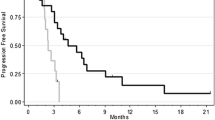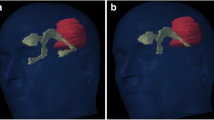Abstract
To test the hypothesis on prolonged survival in glioblastoma cases with increased subventricular zone (SVZ) radiation dose. Sixty glioblastoma cases were previously treated with adjuvant radiotherapy and Temozolamide. Ipsilateral, contralateral and bilateral SVZs were contoured and their doses were retrospectively evaluated. Median follow-up, progression free survival (PFS) and overall survival (OS) were 24.5, 8.5 and 19.3 months respectively. Log-rank tests showed a statistically significant correlation between contralateral SVZ (cSVZ) dose > 59.2 Gy (75th percentile) and poor median PFS (10.37 [95 % CI 8.37–13.53] vs 7.1 [95 % CI 3.5–8.97] months, p = 0.009). cSVZ dose > 59.2 Gy was associated with poor OS in the subgroup with subtotal resection/biopsy (HR: 4.83 [95 % CI 1.71–13.97], p = 0.004). High ipsilateral SVZ dose of > 62.25 Gy (75th percentile) was associated with poor PFS in both subgroups of high performance status (HR: 2.58 [95 % CI 1.03–6.05], p = 0.044) and SVZ without tumoral contact (HR: 10.57 [95 % CI 2.04–49], p = 0.008). The effect of high cSVZ dose on PFS lost its statistical significance in multivariate Cox regression analysis. We report contradictory results compared to previous publications. Changing the clinical practice based on retrospective studies which even do not indicate consistent results among each other will be dangerous. We need carefully designed prospective randomized studies to evaluate any impact of radiation to SVZ in glioblastoma.



Similar content being viewed by others
References
Koshy M, Villano JL, Dolecek TA et al (2012) Improved survival time trends for glioblastoma using the SEER 17 population-based registries. J Neurooncol 107:207–212
Stupp R, Hegi ME, Mason WP et al (2009) Effects of radiotherapy with concomitant and adjuvant temozolomide versus radiotherapy alone on survival in glioblastoma in a randomised phase III study: 5-year analysis of the EORTC-NCIC trial. Lancet Oncol 10:459–466
Stupp R, Mason WP, van den Bent MJ et al (2005) Radiotherapy plus concomitant and adjuvant temozolomide for glioblastoma. N Engl J Med 352:987–996
Oh J, Sahgal A, Sanghera P et al (2011) Glioblastoma: patterns of recurrence and efficacy of salvage treatments. Can J Neurol Sci 38:621–625
Quiñones-Hinojosa A, Sanai N, Soriano-Navarro M et al (2006) Cellular composition and cytoarchitecture of the adult human subventricular zone: a niche of neural stem cells. J Comp Neurol 494:415–434
Singh SK, Clarke ID, Terasaki M et al (2003) Identification of a cancer stem cell in human brain tumors. Cancer Res 63:5821–5828
Galli R, Binda E, Orfanelli U et al (2004) Isolation and characterization of tumorigenic, stem-like neural precursors from human glioblastoma. Cancer Res 64:7011–7021
Bao S, Wu Q, Li Z et al (2008) Targeting cancer stem cells through L1CAM suppresses glioma growth. Cancer Res 68:6043–6048
Cheng L, Wu Q, Huang Z et al (2011) L1CAM regulates DNA damage checkpoint response of glioblastoma stem cells through NBS1. EMBO J 30:800–813
Bao S, Wu Q, McLendon RE et al (2006) Glioma stem cells promote radioresistance by preferential activation of the DNA damage response. Nature 444:756–760
Eramo A, Ricci-Vitiani L, Zeuner A et al (2006) Chemotherapy resistance of glioblastoma stem cells. Cell Death Differ 13:1238–1241
Firat E, Gaedicke S, Tsurumi C et al (2010) Die Bedeutung der Mitotischen Katastrophe nach γ-Bestrahlung von Glioblastomstammzellen. Strahlenther Onkol 186(Suppl 1):116
Bexell D, Gunnarsson S, Nordquist J, Bengzon J (2007) Characterization of the subventricular zone neurogenic response to rat malignant brain tumors. Neuroscience 147:824–832
Mercapide J, Rappa G, Anzanello F, King J, Fodstad O, Lorico A (2010) Primary gene-engineered neural stem/progenitor cells demonstrate tumor-selective migration and antitumor effects in glioma. Int J Cancer 126:1206–1215
Lim DA, Cha S, Mayo MC et al (2007) Relationship of glioblastoma multiforme to neural stem cell regions predicts invasive and multifocal tumor phenotype. Neuro Oncol 9:424–429
Adeberg S, König L, Bostel T et al (2013) Glioblastomrezidivmuster: radiologische Auswertung des Rezidivmusters von 608 Patienten in Bezug auf neuronale Stammzellen der subventrikulären Zone Adeberg. Strahlenther Onkol 189(Suppl 1):24–25
Calabrese C, Poppleton H, Kocak M et al (2007) A perivascular niche for brain tumor stem cells. Cancer Cell 11:69–82
Koshy M, Villano JL, Dolecek TA et al (2012) Improved survival time trends for glioblastoma using the SEER 17 population-based registries. J Neurooncol 107:207–212
Evers P, Lee PP, DeMarco J et al (2010) Irradiation of the potential cancer stem cell niches in the adult brain improves progression-free survival of patients with malignant glioma. BMC Cancer 10:384
Gupta T, Nair V, Paul SN et al (2012) Can irradiation of potential cancer stem-cell niche in the subventricular zone influence survival in patients with newly diagnosed glioblastoma? J Neurooncol 109:195–203
Lee P, Eppinga W, Lagerwaard F et al (2013) Evaluation of high ipsilateral subventricular zone radiation therapy dose in glioblastoma: a pooled analysis. Int J Radiat Oncol Biol Phys 86:609–615
Chen L, Guerrero-Cazares H, Ye X et al (2013) Increased subventricular zone radiation dose correlates with survival in glioblastoma patients after gross total resection. Int J Radiat Oncol Biol Phys 86:616–622
Slotman BJE, Eppinga WSC, de Haan PF, Lagerwaard J (2011) Is irradiation of potential cancer stem cell niches in the subventricular zones indicated in GBM? (abstr 1058). Int J Radiat Oncol Biol Phys 81(Suppl 1):184
Conflict of interest
The authors declare that they have no conflict of interest.
Ethical standards
The authors declare that the study and reporting methodology complies with the current laws.
Author information
Authors and Affiliations
Corresponding author
Rights and permissions
About this article
Cite this article
Elicin, O., Inac, E., Uzel, E.K. et al. Relationship between survival and increased radiation dose to subventricular zone in glioblastoma is controversial. J Neurooncol 118, 413–419 (2014). https://doi.org/10.1007/s11060-014-1424-3
Received:
Accepted:
Published:
Issue Date:
DOI: https://doi.org/10.1007/s11060-014-1424-3




